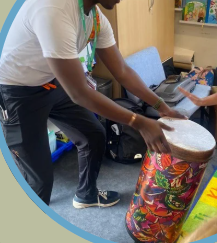Music: An Embodiment of the People
- ianbusinge
- Oct 2
- 2 min read
We begin this blog series with a compelling quote from percussionist and theorist David Penalosa's book, "The Clave Matrix." Throughout this series, I will refer to Mr. Penalosa's work whenever clarity is needed.
"We don't have a name for music; it's just an embodiment of the people." - C.K. Ladzekpo
Below is an extract from a session I prepared for an NHS away-day earlier this year:
The Psychoanalyst Carl Jung's concept of the "Collective Unconscious" is relevant to our understanding and experiencing of music: our musical knowledge and experiences are shared, inherited and unconscious. In the context of music, this is through rhythm, which is common to every human being regardless of individual experiences or cultural background.
It is clear that the idea and realization of beat or pulse, as described by the term "rhythm", is universal among us.
In The Beginning
At the outset, we have the main beats. This is the starting point. Without delving into complex philosophical discussions about what "main beats" entail, we define "main beats" as follows:
... the large, equal units of time, which we naturally seek as focal points. - D, Penalosa, The Clave Matrix
In Practice
These are the beats you typically tap with your foot to maintain rhythm. This week, let's concentrate on a simple exercise: while listening to your favorite music, tap your foot to the beats "1-2-3-4." (Note: The technical assumption here is that the music you're listening to or dancing to is in "4/4" or "Common Time." We'll explore this further as this blog series progresses.)
Are you prepared? Begin tapping and tell me what music you're tapping to (feel free to share a video with us if you're comfortable). See you next time!




Comments